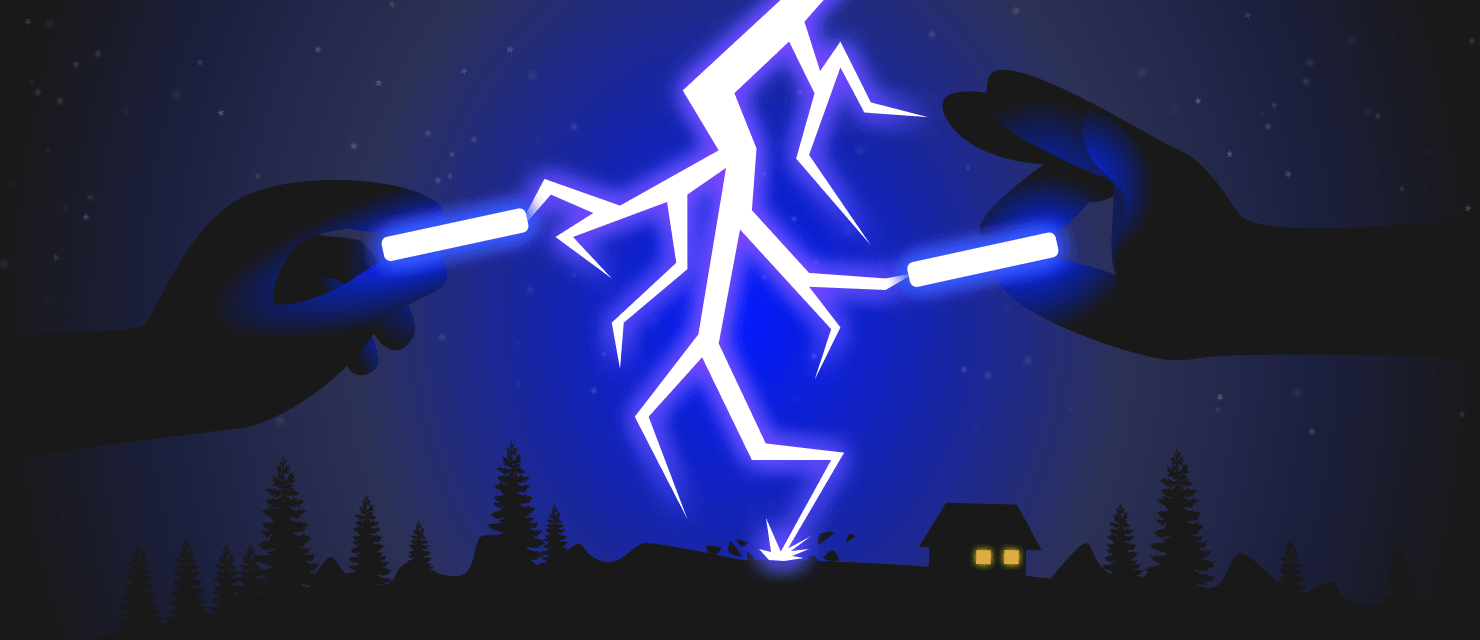The amperage of a lightning bolt is up to 1,250 times higher than that of a power socket. But why exactly does lightning exist, how does it discharge, and what does thunder have to do with it? Let’s figure it out in this article.
Lightning is a huge electrical discharge, which is accompanied by a series of flashes and a thunderclap. Almost always it forms in cumulonimbus clouds, sometimes in large nimbostratus clouds. The upper limit of such clouds often reaches four miles (seven kilometers) above the earth’s surface while the lower part can almost touch the ground. An atmospheric discharge can form both within a single cloud and between nearby electrified clouds, as well as between a cloud and the ground.
A thundercloud consists of a large amount of steam. Because of low temperatures at high altitudes, the steam condenses in the form of ice crystals. Before the cloud becomes a thunderstorm, ice crystals begin to actively move inside it due to warm air streams rising from the heated surface. The warm, moist air rises upward, becomes charged there, discharges again (lightning), heats up, and finally manifests in a loud bang (thunder). We’ll describe this process in more detail later in this article.
How Is Lightning Made
Lightning occurs as a result of the electrostatic charging of water droplets in thunderclouds. The droplets are positively charged in the upper part and negatively charged in the lower part. When the difference in charge is very high, this creates an enormous voltage field.
When lightning is born, charge channels then meet - either directly within a cloud, between clouds, or between the ground and the thundercloud. The voltage discharges in a flash of lightning (spark discharge). A lot of electric current flows, the air in the lightning channel heats up, and the typical glow occurs.
The lightning formation process consists of several stages.
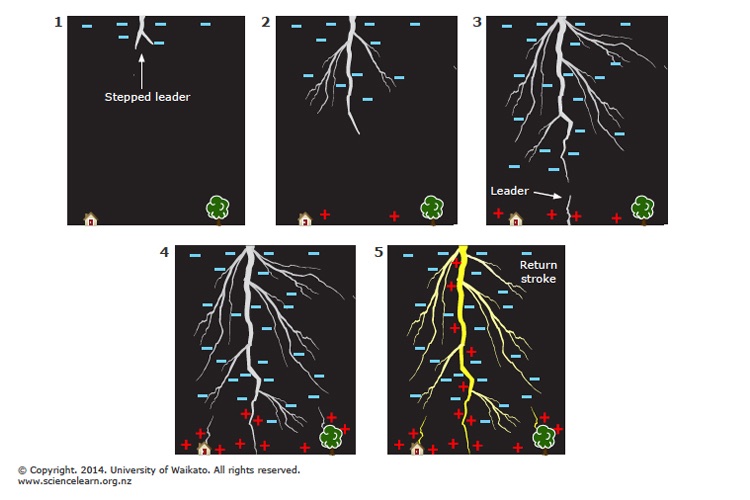
Leader Stage
The lightning discharge starts when the leader appears, having a thermal, mechanical, and electrical effect on the objects through which it passes.
The leader consists of a channel, a channel head, and a streamer zone. The leader channel is a plasma formation through which the current flows. The channel grows by breaking through the gap between the cloud and the earth. It carries a huge potential of tens of megavolts, and the current in it is hundreds of amperes.
Short Circuit Stage
This is the main stage of lightning development. The high-temperature conducting channel short-circuits to the ground, provoking a transient discharge process of an extended charged system that the leader has created. At this stage, a current pulse can flow through the channel at the speed of light.
The short circuit stage is accompanied by flashes of light, a bright glow, and thunder. Vibrations in the air, when a wave of air heated by lightning collides with cold air, cause thunder.
Final Stage
At the final stage, the channel continues to transfer the charge to the ground, but less intensively. However, this stage is characterized by a longer duration of the current, which is mainly due to the thermal effect of lightning.
Types of Lightning
Does lightning come from the ground? Sometimes yes, but not only from the ground. Let’s explore the various forms that lightning can take.
Intracloud and Intercloud Lightning
Most commonly, lightning occurs within a single cloud (intracloud), but sometimes it can travel between two clouds (intercloud).
Cloud-to-Ground Lightning
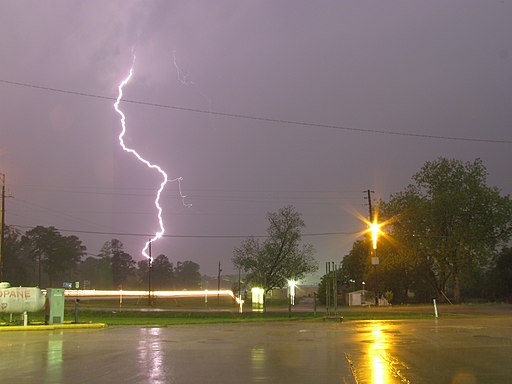 Source: Jrmichae, CC BY-SA 4.0, via Wikimedia Commons
Source: Jrmichae, CC BY-SA 4.0, via Wikimedia Commons
Cloud-to-ground flashes are the glaring arcs of light that run vertically between the bottom of the cloud and the ground. There are two forms of cloud-to-ground lightning: positive and negative lightning.
Negative lightning strikes the earth from a negatively charged cloud base. 90% of the cloud-to-ground lightning transport negative charge to the earth.
Positive lightning originates from a positively charged cloud base and transports this positive charge to the ground. They are twice as strong as ordinary lightning and can strike many miles from the actual thunderstorm. This makes them unpredictable and thus very dangerous for humans and animals. About 10% of lightning is positive but the proportion of positive lightning is higher during the cold season.
Downward and Upward Lightning
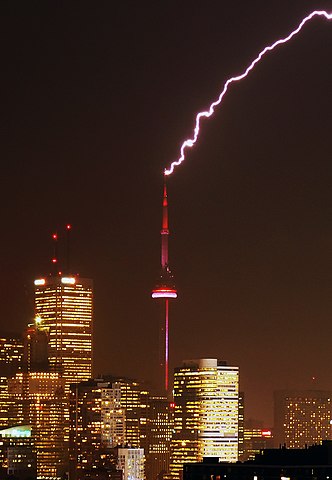 Source: Raul Heinrich, CC BY-SA 3.0, via Wikimedia Commons
Source: Raul Heinrich, CC BY-SA 3.0, via Wikimedia Commons
A so-called leader lightning prepares the visible discharge (return stroke). In almost all lightning, the leader starts in the cloud and grows in steps of 165-655 ft (50-200 m) towards the earth (downward lightning). In special cases (e.g. high towers on mountains), the leader starts at the top of the tower and grows upward into the thundercloud (upward lightning).
Mesosphere Lightnings
High-altitude lightning was first observed and documented by the crew of a space shuttle flight about 30 years ago. These phenomena occur in the mesosphere and there are several types of them called sprites, elves, and blue jets.
In the last 20 years, scientists have been closely observing electrical discharges in the upper atmosphere and the accompanying radiation. For their study, special cameras are installed in the mountains or on orbiting satellites.
Historically, the first studied phenomenon of this kind is sprites. These are electrical discharges that shoot up over thunderstorms or cumulonimbus clouds. Sprites appear as bursts of orange and red radiance, often with a main body, a “trunk”, and numerous branches. In July 1989, scientists from the University of Minnesota made the first pictures of sprites. Since then, sprites have been regularly recorded by both scientists and amateurs and even astronauts from the ISS.
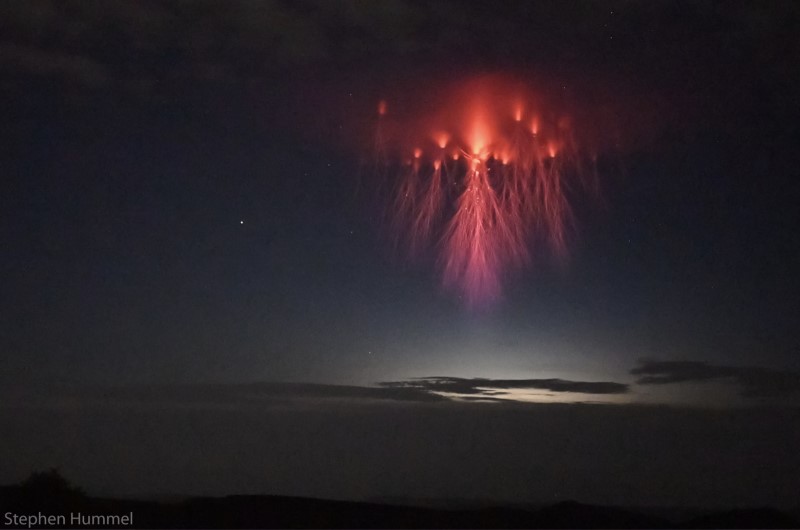 Source: EarthSky
Source: EarthSky
Often, along with sprites, another phenomenon is observed, called “elves” (ELVES, Emission of Light and Very Low-Frequency perturbations due to Electromagnetic Pulse Sources). They appear as rapidly expanding disc-shaped areas of reddish glow that can reach hundreds of kilometers in diameter. As a rule, elves appear at altitudes of about 100 kilometers above powerful storms and last only a few milliseconds.
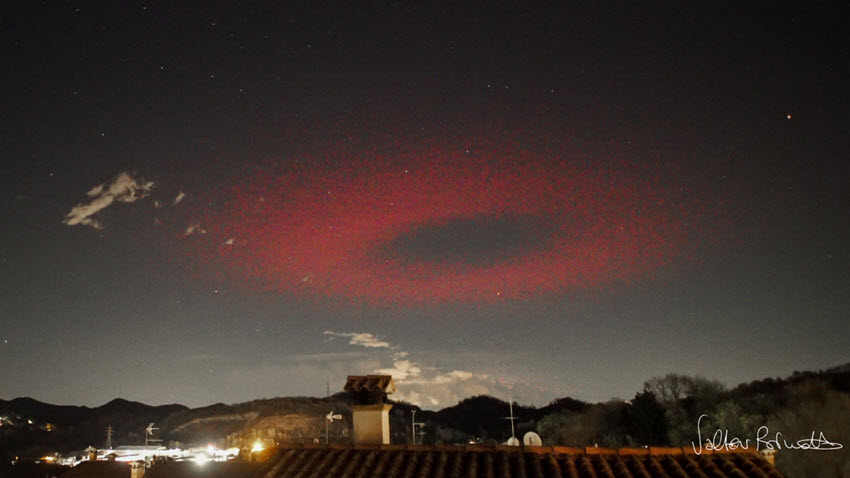 Image credit: Valter Binotto
Image credit: Valter Binotto
Another phenomenon is blue jets. They look like luminous streams emanating from the most active centers of thunderclouds. As they propagate upward, they gradually expand with an opening angle of about 15 degrees. Their glow gradually fades away at an altitude of about 40-50 kilometers. Blue jets are much brighter than sprites and have a different color, but are less common.
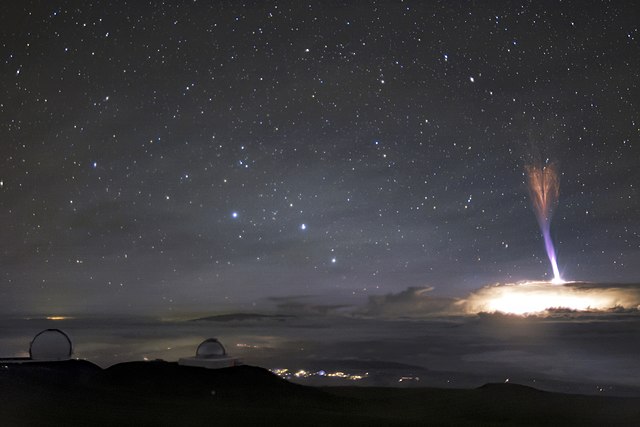 Source: International Gemini Observatory/NOIRLab/NSF/AURA/A. Smith, CC BY 4.0, via Wikimedia Commons
Source: International Gemini Observatory/NOIRLab/NSF/AURA/A. Smith, CC BY 4.0, via Wikimedia Commons
Ball Lightning
Ball lightning is a rare and unexplained phenomenon in which a ball of glowing plasma appears in the atmosphere, typically during thunderstorms. According to eyewitnesses, it looks like a spherical object with a diameter of about 10 to 20 centimeters, although some reports suggest larger sizes.
There are several theories on how this phenomenon appears. One theory suggests that ball lightning forms when lightning strikes the ground, ionizing the surrounding air and creating a plasma ball. Another theory proposes that ball lightning is created when lightning strikes the atmosphere, causing a magnetic field to form around the lightning bolt. This magnetic field then traps ionized gas, creating a ball of plasma.
Ball lightning can last between a few seconds and several minutes, and it is often accompanied by a hissing or crackling sound. It can also move in unpredictable ways, sometimes hovering in place and other times moving quickly or bouncing off surfaces. Ball lightning can even enter buildings through windows or doors but it rarely causes damage or injuries.
Despite many sightings and reports of ball lightning over the years, it remains a mysterious and poorly understood phenomenon. Scientists continue to study ball lightning in an effort to better understand its formation and behavior.
Lightning: Interesting Facts
Here are some interesting facts about lightning:
- Lightning strikes oaks more often than other types of trees. This is because oaks are taller than other trees and have a very developed root system, through which the discharge can easily reach groundwater.
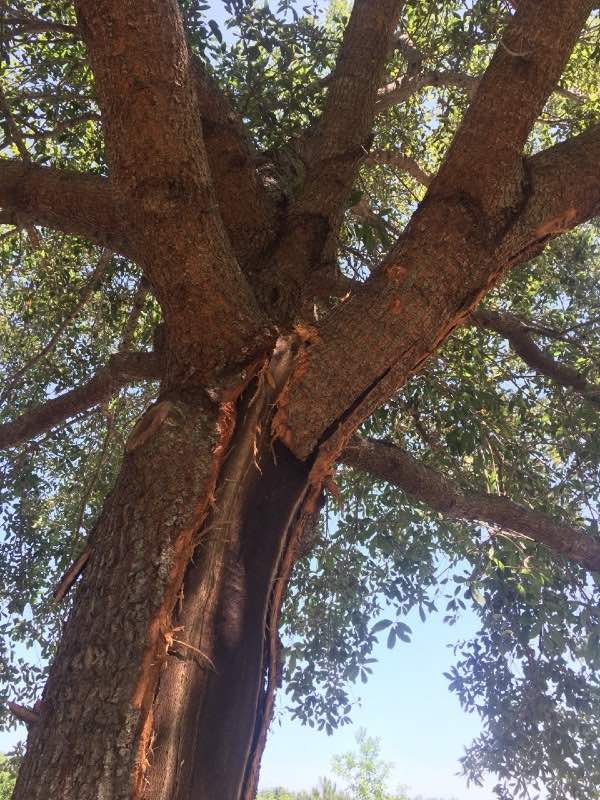 Source: University of Florida Blogs
Source: University of Florida Blogs
- 25% of people struck by lightning die from cardiac arrest. Survivors suffer significant health damage, memory loss, sensitivity, sleep problems, and hearing impairment.
- Lightning hitting the sandy ground can form glass. So, after a thunderstorm, you can find glass formations in the sand.
- What comes first, thunder or lightning? They occur at the same time, but light travels faster than sound. Therefore, we always see the lightning first, and then the thunder follows.
- Lightning can appear not only on our planet but also on others if there are favorable conditions for their formation - a gaseous medium. So, it is possible to observe this phenomenon on Saturn, * Uranus, Venus, and Jupiter. On some of these planets, lightning is hundreds, thousands, and even millions of times more powerful than Earth’s.
- 80% of lightning hits a solid surface, despite the fact that three-quarters of our planet is covered with water. This is because of powerful convection air currents that form over the land.
- Only a quarter of lightning reaches the Earth’s surface. The rest is discharged between clouds.
- Central Africa is part of the world where lightning strikes most frequently.
- Top 3 activities that cause the most lightning deaths in the United States are fishing, beach, and camping. In the table below, you can find more details about activities contributing to lightning fatalities.
| Activity | # of Deaths (%) |
|---|---|
| Fishing | 40 (10%) |
| Beach | 25 (6%) |
| Camping | 21 (5%) |
| Farming or ranching | 20 (5%) |
| Riding bike, motorcycle, or ATV | 19 (5%) |
| Boating | 18 (4%) |
| Social gathering | 16 (4%) |
| Walking to/from home | 16 (4%) |
| Roofing | 15 (4%) |
| Construction | 13 (3%) |
| Soccer | 12 (3%) |
| Yardwork | 12 (3%) |
| Total | 225 (54%) |
Source: National Weather Service
Thunderstorm and Lightning Safety Tips
Here is how you can stay safe during thunderstorms and lightning:
- Stay indoors during thunderstorms. If you hear thunder or see lightning, better stay inside a building or car. Lightning can strike a person even if they are under a tree or other cover.
- Unplug electronics. Unplug appliances, including televisions, computers, and other electronics during thunderstorms to protect them from power surges caused by lightning.
- Avoid water. Avoid swimming, boating, or bathing during thunderstorms, as water is a good conductor of electricity.
- Don’t stand near metal objects, including fences, poles, and umbrellas, as they can attract lightning.
- Wait for the storm to pass. Wait at least 30 minutes after the last clap of thunder before going back outside, because lightning can still strike even after a storm has passed.
- Stay low. If you’re caught outdoors during a thunderstorm and cannot find shelter, crouch down low to the ground, with your feet close together, and cover your ears.
